- Italy Tours Home
- Italy Ethos
- Tours 2023
- Blog
- Contact Us
- Dolomites
- Top 10 Dolomites
- Veneto
- Dolomites Geology
- Dolomiti Bellunesi
- Cortina
- Cadore
- Belluno
- Cansiglio
- Carso
- Carnia
- Sauris
- Friuli
- Trentino
- Ethnographic Museums
- Monte Baldo
- South Tyrol
- Alta Pusteria
- Dobbiaco
- Emilia-Romagna
- Aosta Valley
- Cinque Terre
- Portofino
- Northern Apennines
- Southern Apennines
- Italian Botanical Gardens
- Padua Botanical Garden
- Orchids of Italy
Arte Sella: Where Art and Nature Meet in Perfect Balance.
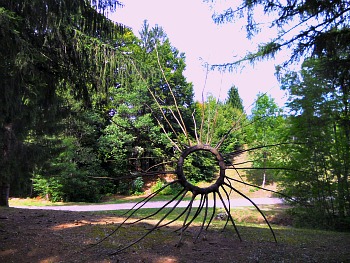
Arte Sella is an international manifestation of contemporary art – born in
1986 – which takes place in the open fields and woods of the Val di Sella
(a side valley of the Valsugana belonging to the municipality of
Borgo Valsugana, in eastern Trentino); it is now run by an association bearing
the same name. In its first period (more on this below) the manifestation was biennial and was taking place by “Casa Strobele” and its park; from 1986
onwards it was developed on the slopes of Monte Armentera (1,500 m) instead – always in
the Valle Sella – as a trail then known as ‘Artenatura’, where alongside a route of approx. 3 km
were placed about 25 works of art.
Since 1998 many of the activities take place around Malga Costa – a rural and isolated building located in the upper section of the valley. The ‘malga’ – once a privately owned dairy used as a traditional cattle shed and for the production of cheese – is now publicly owned and hosts the artists whose works of art are being exhibited in the different editions of the manifestation, as well as being used for temporary exhibitions and other visitor services. In the area surrounding Malga Costa are placed around 30 works of art (Le Soleil, by Francois Lelong – pictured above – is one of those).
This project aims at being not just a high-quality art exhibition, but also – and perhaps above all – at showing an engaging creative process, as every individual piece is followed day by day in its development, and the intervention of the artist has to express a relationship with Nature based on respect, while drawing inspiration and incitement from it.
The works of art are generally tridimensional, as they are obtained from stone, leaves, tree trunks and branches; rarely, more artificial objects and colours are being used (see for instance the image below, depicting A Fior di Pelle/Skin Deep, by Stuart Ian Frost). All the finished pieces are invariably outdoors, and therefore exposed to the elements, which become part of the creative process itself. The visitor can thus see and enjoy the works of art together with the environmental peculiarities of the place where they are located (different types of woodland, for example, or the presence of rocks or monumental trees…). The pieces are immersed within Nature’s vital cycle, and therefore destined to more subtle or overt processes of transformation, degradation and decline, until – possibly – their definitive disappearance.
The exhibitions are often accompanied – especially in the summer season – by concerts, theatre shows and other events that see the participation of famous artists and performers.
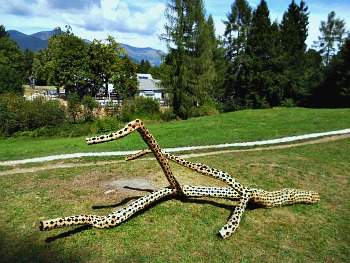
The Botanic Cathedral
In a clearing by Malga Costa the work Cattedrale vegetale (Botanic Cathedral), by Giuliano Mauri, was realized in 2001, and built with more than 3,000 branches crossed in the shape of a three-nave cathedral formed by 80 columns 12 metres high, over 1,220 m² of surface (see the picture below). Inside each column was placed a hornbeam tree, which – in the artist’s intention, at least – once grown should replace the outside structure, eventually destined to rot and die away.
The work had been planned at the end of the 1980s and first presented in Germany; subsequently, it was shown at the Triennale di Milano, but it had never been realized because of its great structural complexity. Once realized in the Valle Sella, this work has enjoyed an enormous success, attracting numerous visitors, and it has secured Arte Sella a place of honour on the trail of international noteworthy places dedicated to the relationship Art/Nature (it is not quite the same as Land Art).
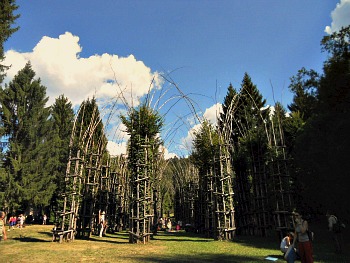
History and Growth of Arte Sella
As can be imagined, however, the history of Arte Sella did not proceed in a straightforward way. The beginnings were marked by some incertitudes, with occasional mistakes and some lucky moments, but in the course of the years the ideas, emotions and love for Art and Nature have shaped a unique manifestation of Contemporary Art which is by now acclaimed at international level.
The idea
In 1986, a local philosopher and
an artist decided to join forces and put their ideas together; coupled with their
love for Art and Nature, they created Arte Sella as a result. Their main goal
was to build an association, rooted at local level, for the development of the concept of Art in
Nature, thus welcoming the cultural and moral renovation expressed by part of the
contemporary art world – as well as by society itself. The fact of being completely
independent from collective art canons – and therefore free to assimilate the new ideas
that the artists were proposing at the time – was the winning intuition behind Arte Sella (the picture below shows a work by Patrick Dougherty: Tana Libera Tutti – an emblematic example of Art and Nature intertwining).
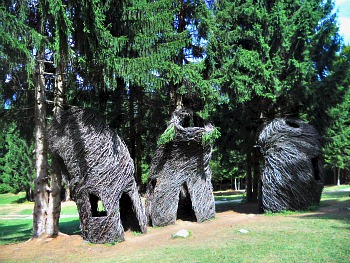
The First Period
The first period is dated between 1986 and 1990. A year had passed from the moment in which the original idea to create ‘Arte Sella’ was born and, together with it, the operative definition of the manifestation. This period was necessary in order to define the first contacts with the foreign artists, cultural institutions and the local population. In that respect, some collaborations were of vital importance; furthermore, this first phase contributed to establish the founding principles that were to guide ‘Arte Sella’ in the years to come.
The fundamental principles were thus determined as such: (a) The artist is no more the absolute protagonist, as it tended to happen in the past (especially with regards to the Land Art movement, characterized by strongly ‘impressive’ signs over the territory); (b) Nature is to be intended as a repository of individual memories; (c) the relationship with ecology is modified: Nature is not protected, but – interpreted in its absence, as it were – it becomes a source of knowledge and experience; (d) the works of art are part of a space and time specific to the place of the intervention but they are not bound by it, and privilege the use of organic, non artificial materials; (e) the works are part of the landscape but they exit it to live their own cycle – only to return to it eventually, always according to Nature’s own times.
The first edition was private; the original group of organizers had called on some artists who were already active and known within Trentino and outside; their goal – in their words – was that of literally “abandoning the works to their decadence and to the splendor of memory”.
Originally, the local population was quite skeptical towards the project, and somehow sneered at it, but later on ‘Arte Sella’ came to be appreciated and accepted as part of the landscape, and integrated as a component of the local heritage (below, the Willow Arcade is portrayed: a delicate intervention with this typically yielding plant, in the area of Malga Costa).
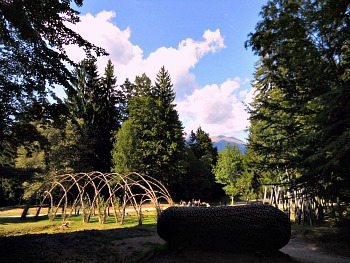
The Second Period
The second period runs between 1990 and 1996. The third edition put into focus the need to associate such project with a valid organization, capable of facing the structural and management difficulties that started to present themselves at this time. The Association “Arte Sella” was created, and its strength resided in the fact of uniting different people and abilities in a collective project that concentrated all efforts towards a unique goal, never betraying the original intutition – love for Art and Nature.
The members of the organization were chosen following a rather unique criterion: their curiosity towards Nature and its “being Art”. Along these lines, the new association was not composed uniquely by artists and artisans but also by common people – and this is precisely what has allowed for the conception of a rather original cultural and artistic operation, in which both experts and amateurs intervene, each contributing according to their capacities. This goal was achieved by harnessing people’s own trade or craft, their personal experience and interests; all this was taken into account as the different roles were attributed within the organization: archive, administration, photography, publicity, public relations, etc. Each had a specific role, but the general decisions were taken collectively at the association’s meetings.
At that point, the help and support – both from a moral and a financial point of view – of the municipality of Borgo Valsugana and of the Autonomous Province of Trento proved themselves indispensible, as to the growth and perfecting of the Arte Sella activities. On top of this, the association started collaborating with other centres that operated with similar finalities, such as Le Centre d’Art de Crestet (F), Tickon (DK) and the Civitella d’Agliano project, Italy.
In 1990 a Scientific Committee was constituted, with the goal of evaluating the artists and their works, and ensure the functions of artistic coordination, also at an international level. So, each year, artists of international renown would follow suit with their installations and works of art in the woods of the Val di Sella, thus contributing to make the event more complete and ever more respondent to the expectations of the organizers. The interventions became ever more complex and gained in depth, drawing on other cultural and religious traditions, which sometimes already contained a strict affinity with Nature and the mountainous environment alike (see, for example, Stupa, by Anton Schaller, in the picture below).
The first editions had been organized in the private setting of Casa Strobele, where the artists worked together with a strong sense of collaboration and friendship. The house was the pulsing heart of the manifestation, and one member recalls: “Here we eat all together around a big wooden table in the garden; we meet around the heart (open fire) in the dining room; here we eat, drink, talk, fight for the bedrooms and some even sleep on improvised ‘rural’ beds (…) here takes place the “fête permanente” (‘permanent feast’) dreamed by the Fluxus artist Robert Filliou – here tensions are put to the side and the artists, as well as the people only previously known on TV, are being met; we communicate, make friends and also plan common projects for the future”. By now, Arte Sella had become a veritable institution.
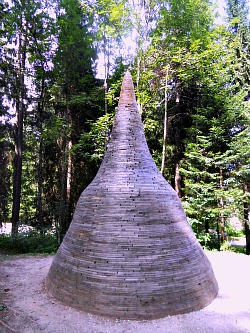
The Third Period: All Change!
From 1996 onwards, the Arte Sella project started to be developed along a forestry trail on the southern slope of Monte Armentera (1,500 m): it was thus defined the route of ‘Arte Natura’ – an itinerary in which the visitor could admire the works of art and enjoy at the same time the environmental peculiarities of the area – such as the different types of woodland, the presence of characteristic rocks, stones or monumental trees.
After several years of activity, the association had acquired not just the experience and resources but also – and perhaps most importantly – the respect and recognition that would allow it to take new directions beyond ‘Arte Natura’.
The strengthening and the diversification of the different activities started in 1998 with the running of Malga Costa, which was conceived mainly – at the beginning – with logistic purposes in mind, but later revealed itself to be actually more indicated to take on the role that was initially assigned to Casa Strobele, as it was the right type of setting in which to host initiatives such as exhibitions or concerts. The ‘malga’ thus became a sort of artistic community – a place of intercultural exchange and meetings as well as of communal life, but also a space for various types of manifestations and creative workshops to take place (in the picture below, Le Ballerine/Dancers, by Armin Schubert, part of the group of works of art around Malga Costa).
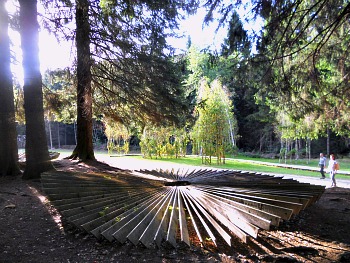
Consolidation
Over the years, time has cancelled certain works, gestures, presences, but – by the same token – it has also clarified and further consolidated some of the intuitions that were at the basis of the project right from the start: first and foremost the choice of place, which still today comes across as fascinating and wild in its own way. Within the association, the feeling and the conviction strengthened that its work had definitely contributed to protect and enhance the local environment, by providing a clue to its discovery and by making it better known and loved by the visitors who arrived in the Val di Sella in ever greater numbers.
So, one first point is the attention and sensitivity to the environment; alongside that, a specific cultural and artistic project has been pursued over the years, and it has consistently grown, gradually gaining a wider consensus among experts, the institutions and those operating in the field of tourism at large – while taking a clearly defined space within the local economy.
Lastly, emphasis was put on a choice of artists who – taken collectively – can represent a real ‘summa’ of what the cultural movement of Art within Nature expresses today at global level.
At the moment, artists with different stories and sensibilities all meet at Arte Sella. They live out collective experiences in order to get to know each other better, and to elaborate as well as to create works of art and installations capable of articulating the bold, thought-provoking language of Contemporary Art and its place within Nature.
It is impossible to foretell what the future will hold for Arte Sella, but one thing is certain: the heart of the manifestation remains – despite its singularity within the field of contemporary art – the creation of a community of people centred not uniquely on the artists and their work but including also the organizers, the visitors, and all those operating behind the scenes, in the conviction that the Earth is not something that can be ‘conquered’ by man, while Nature, Beauty and Culture (in capital letters) are values to be pursued – and actively sought for – with the ultimate intent of enjoying together the harmonious and sustainable development of our Planet: concepts translated here at Arte Sella within the microcosm of this beautiful valley (in the picture below, Stato dAnimo/Mood, by John Verschueren).
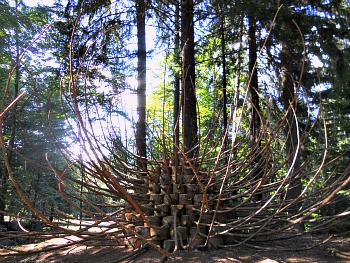
The ‘Arte Natura’ Trail
In the woodlands of the Val di Sella the visitor can appreciate a rare and gratifying experience: the ‘Arte Natura’ Trail. It is an initiative that distances itself quite significantly from the traditional excursions, but that will not fail to bring into life an unforgettable journey across both Nature and its scents as well as Art and its colours. The discovery of a living, uncontaminated entity such as a natural woodland – composed of old rocks interspersed with mosses and majestic trees – will make you enjoy even more the fascination and harmony behind the sculptures and the other works of art that since 1986 are born, live and die back – very much like trees – in this place of indisputable beauty.
The starting point of the ‘Arte Natura’ Trail is by the Strobela Bridge, on the Moggio stream. The works of art are placed along a forestry trail that extends for about 2 km on the southern slope of Monte Armentera. Walking along the path, the visitor can admire both some installations to the side and explore some other pieces which are more secluded, almost concealed by the enticing woodland. Following this route, one eventually reaches “Intersticios” (by Matilde Grau) – an oeuvre that marks a change in the route. Continuing on a very atmospheric country lane one finally gets to the ‘biotope’, which also contains an Alpine pond where several artists have left their mark.
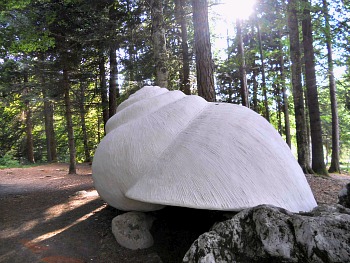
The Area of Malga Costa and the ‘Cattedrale Vegetale’
After having completed the ‘Arte Natura’ Trail and once back on the provincial road, one continues alongside wide, open meadows and pastures dotted with several century-old, monumental trees (especially oak, beech and larch) until reaching the end of the road, where the area of Malga Costa is located. After visiting the annual exhibition, one can continue in the rich woodland of the Val di Sella to access the magnificent ‘Cattedrale Vegetale’ (Botanic Cathedral) – a monumental work realized in 2002 by the Italian artist Giuliano Mauri – and the other installations that constitute the central nucleus of the outdoor exhibition route at Arte Sella (pictured above is Lumaca/Snail, by Alfio Bonanno).
Malga Costa is a rural dairy building that anciently was being used by the farmers and shepherds, who occupied it from spring to autumn for the production of cheese and butter as well as for the shelter of animals. In 1998 the organizers of Arte Sella decided to use this space and to transform it into the headquarters of the association and a Documentation Centre (Arte Sella Documentazione). Thanks to this innovation, each year the visitors can get to know the Arte Sella manifestation not just through exploring the ‘Arte Natura’ Trail but also by actively participating to concerts, theatre plays, creative workshops and photographic exhibitions (portrayed below is Alveare/Beehive, by Daniele Salvalai – part of the group of works of art located around Malga Costa).
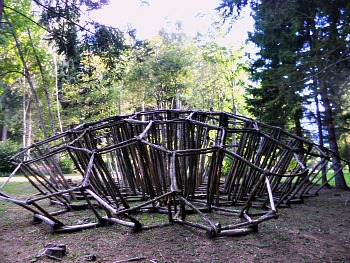
As anticipated above, the space around Malga Costa is now also being used for cultural initiatives. While the interiors mostly host exhibitions, the outdoors spaces are used for theatre plays or concerts; one of the highlights of the year – in that respect – are the initatives connected with the summer festival I Suoni delle Dolomiti (The Sounds of the Dolomites; in the picture below, for instance, is shown an image from last year's edition: the cello duo with Giovanni Sollima and Monika Leskovar – a concert held in the Botanic Cathedral as a homage to the trees).
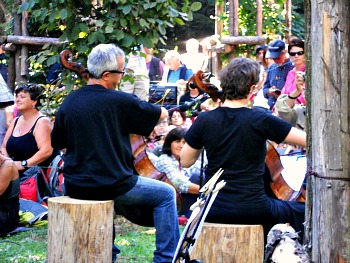
Return from Arte Sella to Valsugana
Return from Arte Sella to Italy-Tours-in-Nature
Copyright © 2013 Italy-Tours-in-Nature

New! Comments
Have your say about what you just read! Leave me a comment in the box below.